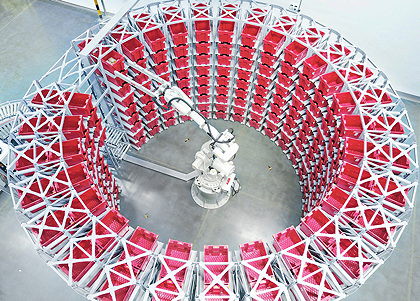- Home » News » Technology News
John Lewis pilots flexible robotic storage system

ABB has announced a robotic storage system that can sequence, buffer, store and consolidate a wide variety of items for organisations of all sizes. It says that the FlexBuffer cell will bring new levels of flexibility to sectors including logistics, food and beverage, consumer packaged goods and retailing.
Pilot users of the system include the UK retailer John Lewis & Partners, which is using it for order picking, the Chinese phone-maker Huawei, which has created an automated retail store where customers can pick up phones they have ordered, and a Chinese hospital, which is using the system for pharmaceutical storage and bin-picking.
ABB says that most existing systems for automated goods handling are large, expensive to install, and lack the flexibility to provide the buffering and order sequencing capabilities that users need.
Marc Segura, group senior vice-president and managing director of ABB Consumer Segments & Service Robotics, says that the new system will offer users “the flexibility to store and retrieve goods as they want, in any sequence to suit their operation and customers’ needs, as well as the ability to quickly scale up their operations if required. Now, any size operation, from large stores to small pharmacies, can achieve maximum efficiency in handling a wide range of items.”
The system consists of an ABB robot, a suite of grippers, a software package, storage racks, and infeed and outfeed conveyors that feed and dispatch the goods.
The configurable storage management software, which interfaces with WMS, ERP and AMS systems, manages incoming orders and optimises the system for buffering, storage and sequencing operations. It can store and retrieve a mixture of items, avoiding collisions and optimising the use of storage space. It can control single or multiple FlexBuffer cells and allows operations to be scaled up easily to meet changing demands.
ABB expects this scalability to be especially attractive for smaller facilities such as retail stores, pharmacies, hospitals, and fulfilment centres that need adaptable and flexible storage and retrieval systems.
Information from the software is used by the robot to store goods in the appropriate rack positions, based on the sequence in which they will be dispatched. When objects need to be retrieved, the robot can pick the requested goods in the right sequence and place them on the outbound conveyor, ready for dispatch. Ordering goods to pre-defined sequences allows companies to achieve delivery times and to fill customised orders on the basis of item weights, temperatures or other attributes.
The software can also help to satisfy the growing demand for live order tracking, with customers able to track the progress of their orders continuously.

The FlexBuffer system can handle payloads of up to 50kg. It can store up to 600 totes and conduct sequencing operations at a rate of up to 500 cycles per hour. It can help companies form order consolidation buffers (OCBs), allowing goods to be stored temporarily before they undergo further processing.
The system is available in either single- and mixed-item versions. The former handles standard boxes used to transport items, while the latter offers added flexibility by using adjustable grippers that can handle items such as parcels, trays, and crates.
Following ABB’s recent acquisition of the Spanish AMR (autonomous mobile robot) manufacturer Asti, AMRs could be used in conjunction with the buffer system to add even more flexibility to logistics operations. ABB claims that it is the only company able to offer a complete portfolio for the next generation of flexible automation.
The John Lewis pilot installation consists of two single-robot FlexBuffer cells, protected by safety fencing. The system has 844 tote storage locations – 422 per cell. Around 266 totes enter each cell every hour and are stored and retrieved from racks within a 25 second cycle time without needing any manual intervention.
ABB Robotics: Twitter LinkedIn Facebook






